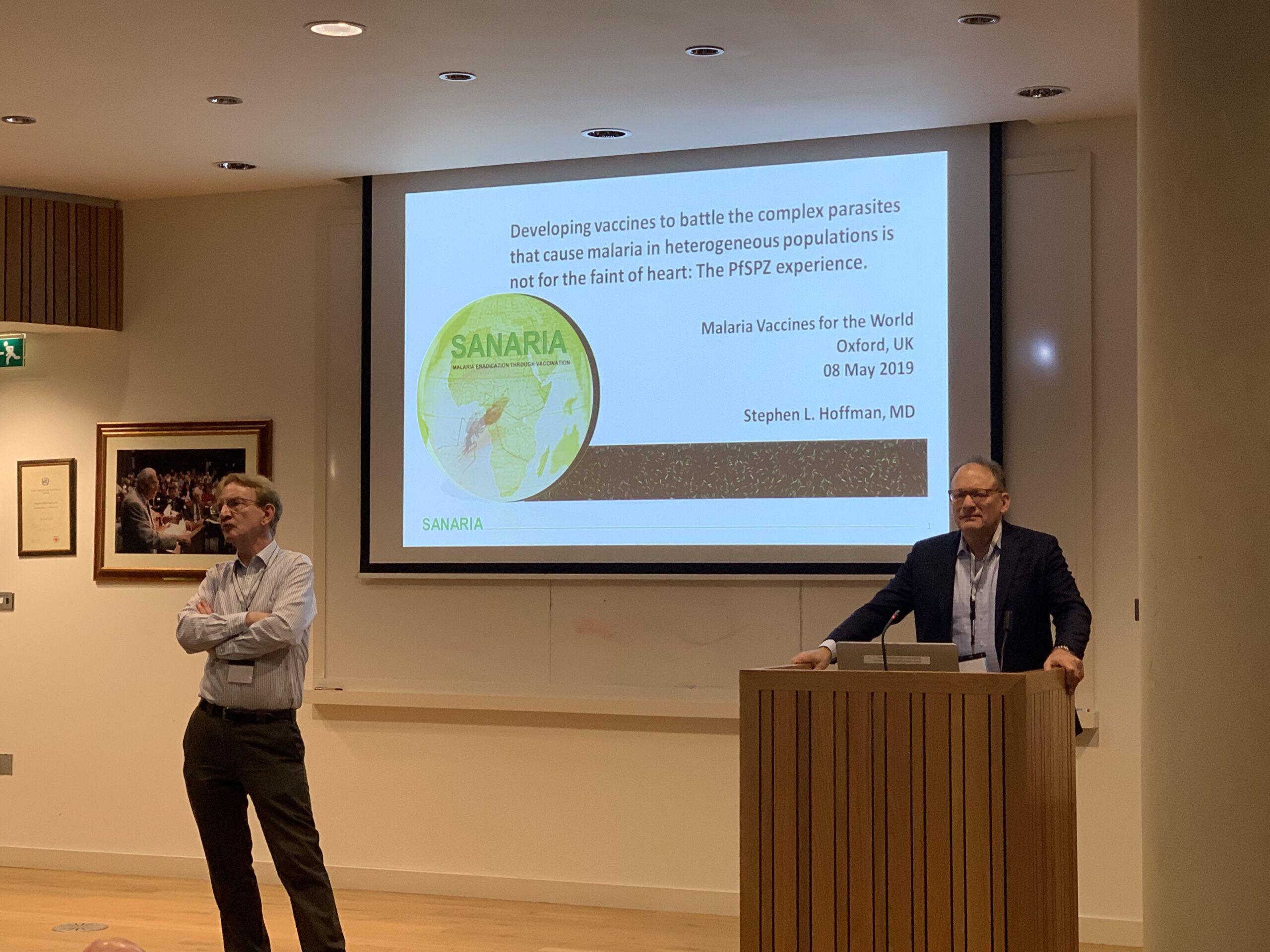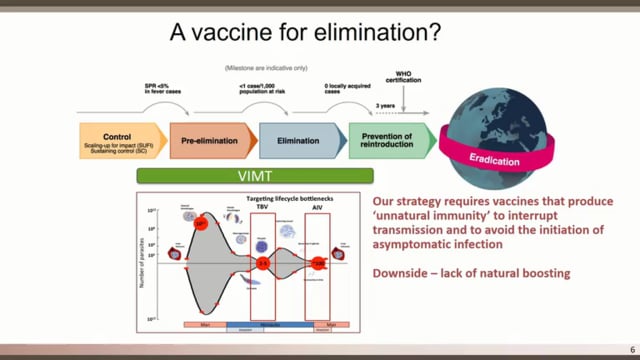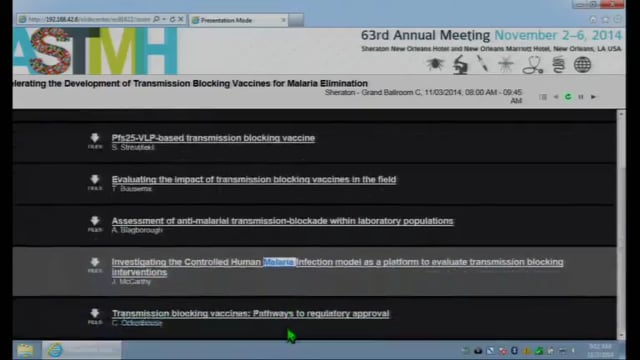5th International Conference on Malaria Vaccines for the World (MVW) – 2019: Day 1
Wednesday, 8th May 2019
Published: 12/05/2019
This report is brought to you by the MESA Correspondents Rebeca Santano, and Robert Mitchell.
THEMES: THEMES: Basic Science | Epidemiology | Health Systems
MESA Correspondents bring you cutting-edge coverage from the 5th International Conference on Malaria Vaccines for the World (MVW).
Simon Draper (University of Oxford) kicked-off the conference and introduced the content of day 1, focused mostly on pre-erythrocytic Plasmodium falciparum sporozoite PfSPZ-based vaccines and blood-stage vaccines.
SESSION 1: OPENING PLENARY SESSION
Adrian V.S. Hill (University of Oxford) gave an overview of the development of multi-stage malaria vaccines at the University of Oxford. Despite the challenges for a malaria vaccine to be effective, requiring induction of an exceptional immunogenicity with extremely high antibody levels and T cells frequencies, recent advances point to the feasibility of achieving a subunit vaccine for malaria endemic countries. He summarized the latest advances on safety, immunogenicity and efficacy of the R21/Matrix-M vaccine designed to induce high antibody titers, the prime-target strategy with viral vectors to induce liver resident memory T cells, and briefly on transmission blocking sexual stage vaccines.
Stephen L. Hoffman (Sanaria) gave an overview of Sanaria’s malaria vaccine development plans, including target populations in Africa and travellers from high-income countries. Hurdles faced include the complexity of the human immune response and dysregulation due to previous exposure, and different responsiveness depending on age or genetic background, as well as the complexity of the parasite, in terms of variation of target epitopes and transmission intensity. He also presented the goals and timelines for the licensing of the PfSPZ vaccine, and the studies to halt the transmission and eliminate malaria in Bioko Island, Equatorial Guinea.
SESSION 2: PFSPZ-BASED VACCINES: PHASE 3 TO LICENSURE TO DEPLOYMENT TO USE IN ELIMINATION CAMPAIGNS TO NEXT GENERATIONS
Stephen L. Hoffman (Sanaria) presented plans for finalizing the immunization regimen for the PfSPZ vaccine Phase 3 clinical trials in non-immune populations. He covered how the schedule was optimized regarding dose and intervals, as well as the verification of the optimal regimen against homologous and heterologous Controlled Human Malaria Infections (CHMI). He presented the 3-dose regime, which has shown a high efficacy in two subsequent CHMI and heterologous CHMI. Next, Said Jongo (Ifakara Health Institute and Bioko Island Malaria Elimination Program) presented the plans for finalizing the immunization regimen for the PfSPZ vaccine for Phase 3 clinical trials in semi-immune adults in Africa. He concluded that 3 doses given on days 1, 8, and 29 were as good if not better than a 5-dose regimen observed in previous studies.
Thomas L. Richie (Sanaria) presented the current status and mid term plans for the PfSPZ vaccine. The immediate goal is to obtain marketing authorization. He reviewed safety data of 4,902 doses of PfSPZ in 1,526 volunteers (5 months to 65 years in age) showing the vaccine to be safe and well tolerated. Future studies include evaluating the value of boosting, the feasibility of a vaccine for pregnant women, and cross species protection. Peter Billingsley (Sanaria) (on behalf of Salim Abdulla, Ifakara Health Institute and Bioko Island Malaria Elimination Program) covered the Equatorial Guinea Malaria Vaccine Initiative testing the PfSPZ vaccine in Bioko Island. Cluster randomized trials will be performed to test mass vaccine effect, as well as a “stepped wedge” approach to optimize standard malaria control efforts coupled with full vaccine coverage for an effective elimination program. Patrick Duffy (Laboratory of Malaria Immunology and Vaccinology, NIAID, NIH) (on behalf of Agnes Mwakingwe, Laboratory of Malaria Immunology and Vaccinology, NIAID, NIH) presented data on PfSPZ-CVac trials using chloroquine and, for the first time, pyrimethamine. A high dose regime with pyrimethamine was safe, well-tolerated, prevented blood stage parasitemia and may induce heterologous sterile protection.
Shahid Khan and Meta Roestenberg (Leiden University Medical Center) presented the results of the first efficacy trial of an early arresting genetically attenuated PfSPZ vaccine with two knock-out genes, PfSPZ-GA1, administered by needle and syringe in malaria naïve adults challenged with mosquito bites. Overall, PfSPZ-GA1 was safe and well tolerated but sterile protection was achieved in only 3/26 volunteers, with a delayed parasitemia up to day 12. PfSPZ-GA1 and PfSPZ vaccines exhibited similar immunogenicity in terms of antibody and cellular responses. Next, Ashley Vaughan (Seattle Children’s Hospital Research Foundation) presented the results of the efficacy trial of another Genetically Attenuated Parasite (GAP) vaccine with three knock-out genes, PfSPZ-GAP3KO. Half of the volunteers immunized with two different regimens became infected, with no delay in prepatency.
SESSION 3: PFSPZ-BASED VACCINES: INNOVATIONS AND IMMUNOLOGY TO IMPROVE EFFICACY AND REDUCE COST OF GOODS
Abraham Eappen (Sanaria) presented the successful in vitro production of PfSPZ (iPfSPZ), showing that cultured iPfSPZ are fully infectious, develop similar oocysts as those produced in vivo (in the mosquito), and the yield is three-fold greater. This technology will help achieve an efficient, scalable and automatable system that will reduce the cost of goods for vaccine development. B. Kim Lee Sim (Sanaria) presented work done at Sanaria to take into account the genetic diversity and breadth of protective immunity using hybrid strains and mixed strains of PfSPZ. The goal is to seek genetic diversity using different strains and keep selected phenotypic characteristics of NF54.
Shahid Khan and Chris Janse (Leiden University Medical Center) then presented efforts to develop the next generation of late liver stage arresting GAP vaccines in mice. Transgenic Plasmodium berghei parasites expressing Plasmodium falciparum Pf48/45 can be used to assess the transmission blocking potential of the vaccine candidate. Rodent parasites can express P. falciparum antigens in their native form. They can be used as effective expression systems, as well as means to rapidly characterize P. falciparum vaccine candidates. Next, Stefan Kappe (Seattle Children’s Hospital Research Foundation) presented work on the generation of genetically-engineered replication-competent whole P. falciparum parasite vaccines. Comparing replication-competent (LARC GAP) with replication-deficient (EARD GAP) vaccines, better responses and protection are obtained when the parasite develops further and the host immune system is exposed to a larger and more diverse biomass of antigens.
Stephen L. Hoffman (Sanaria) (on behalf of Sumana Chakravarty, Sanaria) presented Sanaria’s strategies for improving immunogenicity of PfSPZ vaccines by the use of adjuvants, showing increased levels of protection in mice. Next, Claudia Daubenberger (Swiss TPH) presented lessons learned from immunological studies in PfSPZ vaccine trials in malaria pre-exposed people. IgM antibodies were induced that targeted the circumsporozoite protein (CSP) and inhibit sporozoite invasion and growth in hepatocytes. Unconventional T-cell subsets analyzed by high-dimensional flow cytometry showed an expansion and phenotypic change upon blood stage parasitemia. Vγδ1 T cells appear to be involved in malaria immunity in a way that acts in an adaptive-like, long-term alteration of the immune response after encountering blood stage infections.
Finally, Stephen L. Hoffman presented strategies to complement vaccine protection with human monoclonal antibodies (mAbs). Several population groups such as the elderly, infants, HIV-positive individuals, vaccine non-responders, travellers and military personnel could benefit from the immediate protection afforded by injection of protective mAbs. Sanaria performed comparative analysis with the mouse mAb 2A10 by immunofluorescence assays (IFA) and Inhibition of Sporozoite Invasion (ISI) assays and ELISA with the anti-PfCSP human mAb as reference standard. Next steps include further functional assays to finalize the prioritization and selection of the best mAb(s) for further development.
SESSION 4: RECENT ADVANCES – BLOOD-STAGE VACCINES
Sarah Silk (University of Oxford) presented the safety, immunogenicity and efficacy of vaccine candidates based on PfRH5, a leading blood stage target, tested in Phase I/IIa clinical trials. RH5.1/AS01B induced higher antibody response than VV-RH5. RH5.1/AS01B was safe and well-tolerated, with no differences in antibody magnitude between doses. A 10μg dose following the 0-1-2 month regimen showed a modest but significant impact on parasite multiplication rate (PMR) following CHMI and reboosting, and re-challenging 4 months later resulted in higher antibody responses and impact on PMR. Next, Carolyn Nielsen (University of Oxford) presented work on antigen-specific CD4+ T follicular helper (Tfh) cell responses to RH5 in the two vaccine trials testing the ChAd63-MVA and protein/AS01B formulations. A negative correlation was observed between anti-RH5 IgG and IFNγ measured by ELISPOT, with higher IgG levels and lower IFNγ in the protein/AS01B platform. RH5.1/AS01B induced higher antigen-specific Tfh responses, which correlated with anti-PfRH5 IgG levels, RH5-specific memory B cells, and antibody functionality. A Th2 skew in the CD4+ T cell response was seen in the antigen-specific supernatant cytokine profile with the protein/AS01 platform that may be linked to an enhanced B cell response and IgG production. In contrast, a Th1 skew was seen with the ChAd63-MVA formulation.
Thomas Lavstsen (University of Copenhagen) finished the session with a talk on the status of vaccine development based on VAR2CSA and CIDRα1 PfEMP1, including findings from a phase I trial. The next steps for VAR2CSA vaccines are creating antigen decorated capsid particles (VLP) using bacteriophage ap205 or HPV for a clinical test of VAR2CSA-HPV vaccine. Antigenic variation is limited for CIDRα1, therefore it can be a prime target for vaccination. Mosaic VLPs will also be used to generate cross-reactive B cells.
Simon Draper closed the meeting by thanking the speakers and wishing everyone a relaxing evening to recover from an intense day.
This daily report has been written by Rebeca Santano and Robert Mitchell (ISGlobal) as part of the MESA Correspondents program. Senior editorial support and expertise have been provided by Dr Carlota Dobaño (ISGlobal).
Published: 12/05/2019
This report is brought to you by the MESA Correspondents Rebeca Santano, and Robert Mitchell.
THEMES: Basic Science | Epidemiology | Health Systems


